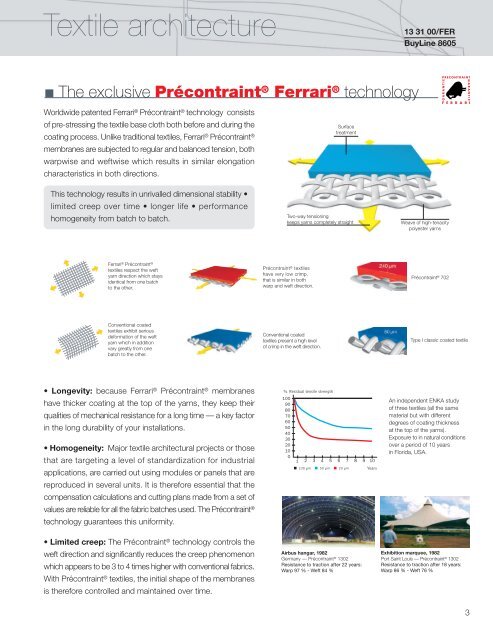Ferrari 1502 S Tensile Structure Systems
Ferrari 1502 S Tensile Structure Systems
Ferrari 1502 S Tensile Structure Systems
You also want an ePaper? Increase the reach of your titles
YUMPU automatically turns print PDFs into web optimized ePapers that Google loves.
Textile architecture<br />
13 31 00/FER<br />
BuyLine 8605<br />
The exclusive Précontraint ® <strong>Ferrari</strong> ® technology<br />
Worldwide patented <strong>Ferrari</strong> ® Précontraint ® technology consists<br />
of pre-stressing the textile base cloth both before and during the<br />
coating process. Unlike traditional textiles, <strong>Ferrari</strong> ® Précontraint ®<br />
membranes are subjected to regular and balanced tension, both<br />
warpwise and weftwise which results in similar elongation<br />
characteristics in both directions.<br />
This technology results in unrivalled dimensional stability •<br />
limited creep over time • longer life • performance<br />
homogeneity from batch to batch.<br />
Surface<br />
treatment<br />
Two-way tensioning<br />
keeps yarns completely straight<br />
Weave of high-tenacity<br />
polyester yarns<br />
<strong>Ferrari</strong> ® Précontraint ®<br />
textiles respect the weft<br />
yarn direction which stays<br />
identical from one batch<br />
to the other.<br />
Précontraint ® textiles<br />
have very low crimp,<br />
that is similar in both<br />
warp and weft direction.<br />
Précontraint ® 702<br />
Conventional coated<br />
textiles exhibit serious<br />
deformation of the weft<br />
yarn which in addition<br />
vary greatly from one<br />
batch to the other.<br />
Conventional coated<br />
textiles present a high level<br />
of crimp in the weft direction.<br />
Type I classic coated textile<br />
• Longevity: because <strong>Ferrari</strong> ® Précontraint ® membranes<br />
have thicker coating at the top of the yarns, they keep their<br />
qualities of mechanical resistance for a long time — a key factor<br />
in the long durability of your installations.<br />
• Homogeneity: Major textile architectural projects or those<br />
that are targeting a level of standardization for industrial<br />
applications, are carried out using modules or panels that are<br />
reproduced in several units. It is therefore essential that the<br />
compensation calculations and cutting plans made from a set of<br />
values are reliable for all the fabric batches used. The Précontraint ®<br />
technology guarantees this uniformity.<br />
• Limited creep: The Précontraint ® technology controls the<br />
weft direction and significantly reduces the creep phenomenon<br />
which appears to be 3 to 4 times higher with conventional fabrics.<br />
With Précontraint ® textiles, the initial shape of the membranes<br />
is therefore controlled and maintained over time.<br />
% Residual tensile strength<br />
100<br />
90<br />
80<br />
70<br />
60<br />
50<br />
40<br />
30<br />
20<br />
10<br />
0<br />
1 2 3 4 5 6 7 8 9 10<br />
Years<br />
■ 230 µm ■ 50 µm ■ 20 µm<br />
Airbus hangar, 1982<br />
Germany — Précontraint ® 1302<br />
Resistance to traction after 22 years:<br />
Warp 97 % - Weft 84 %<br />
An independent ENKA study<br />
of three textiles (all the same<br />
material but with different<br />
degrees of coating thickness<br />
at the top of the yarns).<br />
Exposure to in natural conditions<br />
over a period of 10 years<br />
in Florida, USA.<br />
Exhibition marquee, 1982<br />
Port Saint Louis — Précontraint ® 1302<br />
Resistance to traction after 18 years:<br />
Warp 86 % - Weft 76 %<br />
3


